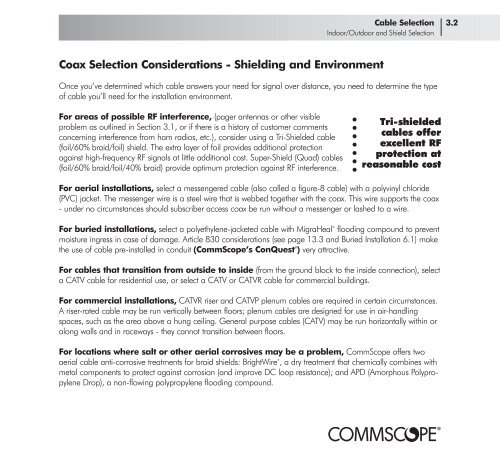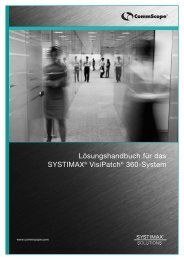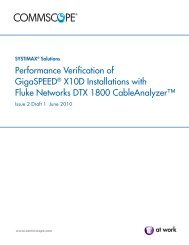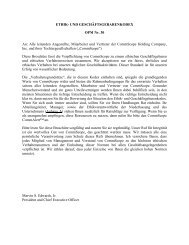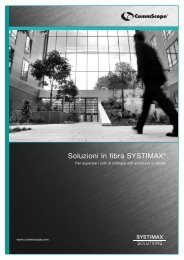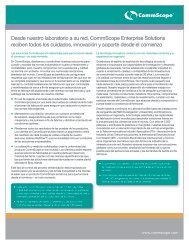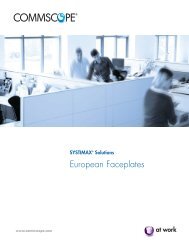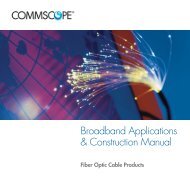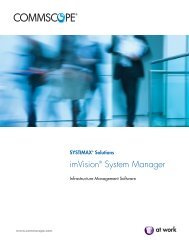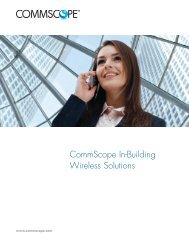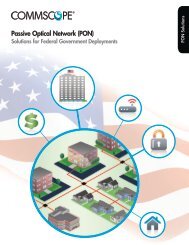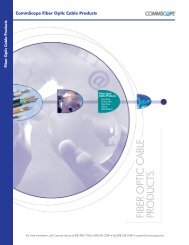Broadband Applications & Construction Manual - Public - CommScope
Broadband Applications & Construction Manual - Public - CommScope
Broadband Applications & Construction Manual - Public - CommScope
You also want an ePaper? Increase the reach of your titles
YUMPU automatically turns print PDFs into web optimized ePapers that Google loves.
Coax Selection Considerations - Shielding and Environment<br />
Once you’ve determined which cable answers your need for signal over distance, you need to determine the type<br />
of cable you’ll need for the installation environment.<br />
For areas of possible RF interference, (pager antennas or other visible<br />
problem as outlined in Section 3.1, or if there is a history of customer comments<br />
concerning interference from ham radios, etc.), consider using a Tri-Shielded cable<br />
(foil/60% braid/foil) shield. The extra layer of foil provides additional protection<br />
against high-frequency RF signals at little additional cost. Super-Shield (Quad) cables<br />
(foil/60% braid/foil/40% braid) provide optimum protection against RF interference.<br />
Cable Selection 3.2<br />
Indoor/Outdoor and Shield Selection<br />
Tri-shielded<br />
cables offer<br />
excellent RF<br />
protection at<br />
reasonable cost<br />
For aerial installations, select a messengered cable (also called a figure-8 cable) with a polyvinyl chloride<br />
(PVC) jacket. The messenger wire is a steel wire that is webbed together with the coax. This wire supports the coax<br />
- under no circumstances should subscriber access coax be run without a messenger or lashed to a wire.<br />
For buried installations, select a polyethylene-jacketed cable with MigraHeal ®<br />
flooding compound to prevent<br />
moisture ingress in case of damage. Article 830 considerations (see page 13.3 and Buried Installation 6.1) make<br />
the use of cable pre-installed in conduit (<strong>CommScope</strong>’s ConQuest ®<br />
) very attractive.<br />
For cables that transition from outside to inside (from the ground block to the inside connection), select<br />
a CATV cable for residential use, or select a CATV or CATVR cable for commercial buildings.<br />
For commercial installations, CATVR riser and CATVP plenum cables are required in certain circumstances.<br />
A riser-rated cable may be run vertically between floors; plenum cables are designed for use in air-handling<br />
spaces, such as the area above a hung ceiling. General purpose cables (CATV) may be run horizontally within or<br />
along walls and in raceways - they cannot transition between floors.<br />
For locations where salt or other aerial corrosives may be a problem, <strong>CommScope</strong> offers two<br />
aerial cable anti-corrosive treatments for braid shields: BrightWire ®<br />
, a dry treatment that chemically combines with<br />
metal components to protect against corrosion (and improve DC loop resistance); and APD (Amorphous Polypropylene<br />
Drop), a non-flowing polypropylene flooding compound.


